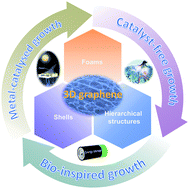Scalable chemical-vapour-deposition growth of three-dimensional graphene materials towards energy-related applications
Abstract
Three-dimensional (3D) graphene materials, which are integrated using graphene structural units, show great promise for energy-related applications because of the high specific surface area, fast electron transport, and low density. Beyond solution-phase assembly of graphene sheets, chemical vapour deposition (CVD) has been recently introduced as a scalable, high-yield, and facile strategy for preparing 3D graphene materials with relatively high crystallinity and controllable layer numbers. Such 3D graphene structures have served as ideal platforms for constructing next-generation energy storage and conversion devices such as supercapacitors, batteries, and fuel cells. In this tutorial review, we focus on recent progress in the scalable CVD growth of 3D graphene materials (e.g., foams, shells, and hierarchical structures) as well as their applications in energy-related fields. First, we emphasize the role of substrate shape and composition (metal or non-metal) in the CVD growth of diverse 3D graphene materials. The related growth mechanisms of these 3D graphene materials are also analysed and discussed. Second, we demonstrate the applications of the CVD-derived 3D graphene materials in various energy-related devices. Finally, we conclude this review with our insights into the challenges and future opportunities for CVD synthesis as well as the application of such intriguing 3D graphene materials.

- This article is part of the themed collection: 2D nanomaterials: graphene and transition metal dichalcogenides


 Please wait while we load your content...
Please wait while we load your content...